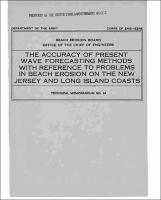Please use this identifier to cite or link to this item:
https://hdl.handle.net/11681/3365| Title: | The accuracy of present wave forecasting methods with reference to problems in beach erosion on the New Jersey and Long Island coasts |
| Authors: | United States. Army. Office of the Chief of Engineers New York University. School of Engineering and Science Pierson, Willard J. |
| Keywords: | Beach Erosion Long Branch (N.J.) Long Island (N.Y.) Water Waves |
| Publisher: | United States, Beach Erosion Board Engineer Research and Development Center (U.S.) |
| Series/Report no.: | Technical memorandum (United States. Beach Erosion Board) ; no. 24. |
| Description: | Technical Memorandum From the Introduction: Detailed weather data and wave data for every four hours were obtained from 22 April, 1948 to 31 May, 1948. An attempt was made to fit the observed significant height and significant period to the forecasted significant height and significant period within the range of accuracy of the weather data. It was, in general, possible to obtain good agreement between the observed and forecasted significant heigths. Various examples of the techniques employed are described. In particular, an east coast storm and tropical hurricane are studied. The data were tabulated with reference to single valued versus multiple valued forecasts, and with reference to accepted wave forecasting methods, and, as yet, theoretically unjustified extensions. Since good wave height agreement was obtained by a deliberate choice of forecase parameters within the range of their possible values, only the accuracy of the period forecast is discussed. A statistical study of the results obtained shows that the forecasted significant periods, no matter what the method, are not accurate and that they have not been distributed according the the distribution of the observed significant periods. More accurate forecasts would be obtained by making a simple climatological forecast, that is, by forecasting the average value of all observed significant periods in all cases. Table 10 summarizes the statistical results which were obtained. An attempt is made to verify the refraction diagram for Long Branch, New Jersey. It is shown that the forecasted values for deep water were so inaccurate that verification of the diagram is not possible. The data are sufficiently adequate, however, to permit the qualitative discussion of problems connected with beach erosion. The dirrection of littoral current for various deep water wave directions is discussed both for waves from a distance and for local waves. Some of the effects of an east coast storm on the shore line are described, and the statistical properties of east coast storms are given. It is concluded that hindcasts which are made in order to obtain statistical data about waves at a given location may not be accurate enough to be worth the effort involved. In addition, any problem in wave action which depends critically upon the wave period cannot be accurately handled by the present forecasting methods. |
| Rights: | Approved for Public Release, Distribution is Unlimited |
| URI: | http://hdl.handle.net/11681/3365 |
| Appears in Collections: | Technical Memorandum |
Files in This Item:
| File | Description | Size | Format | |
|---|---|---|---|---|
| BEB-TM-24.pdf | 6.29 MB | Adobe PDF |  View/Open |